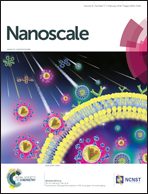Patterned, highly stretchable and conductive nanofibrous PANI/PVDF strain sensors based on electrospinning and in situ polymerization†
Abstract
A facile fabrication strategy via electrospinning and followed by in situ polymerization to fabricate a patterned, highly stretchable, and conductive polyaniline/poly(vinylidene fluoride) (PANI/PVDF) nanofibrous membrane is reported. Owing to the patterned structure, the nanofibrous PANI/PVDF strain sensor can detect a strain up to 110%, for comparison, which is 2.6 times higher than the common nonwoven PANI/PVDF mat and much larger than the previously reported values (usually less than 15%). Meanwhile, the conductivity of the patterned strain sensor shows a linear response to the applied strain in a wide range from 0% to about 85%. Additionally, the patterned PANI/PVDF strain sensor can completely recover to its original electrical and mechanical values within a strain range of more than 22%, and exhibits good durability over 10 000 folding−unfolding tests. Furthermore, the strain sensor also can be used to detect finger motion. The results demonstrate promising application of the patterned nanofibrous membrane in flexible electronic fields.


 Please wait while we load your content...
Please wait while we load your content...